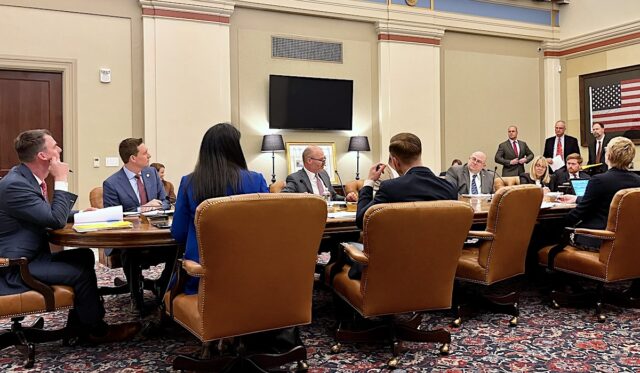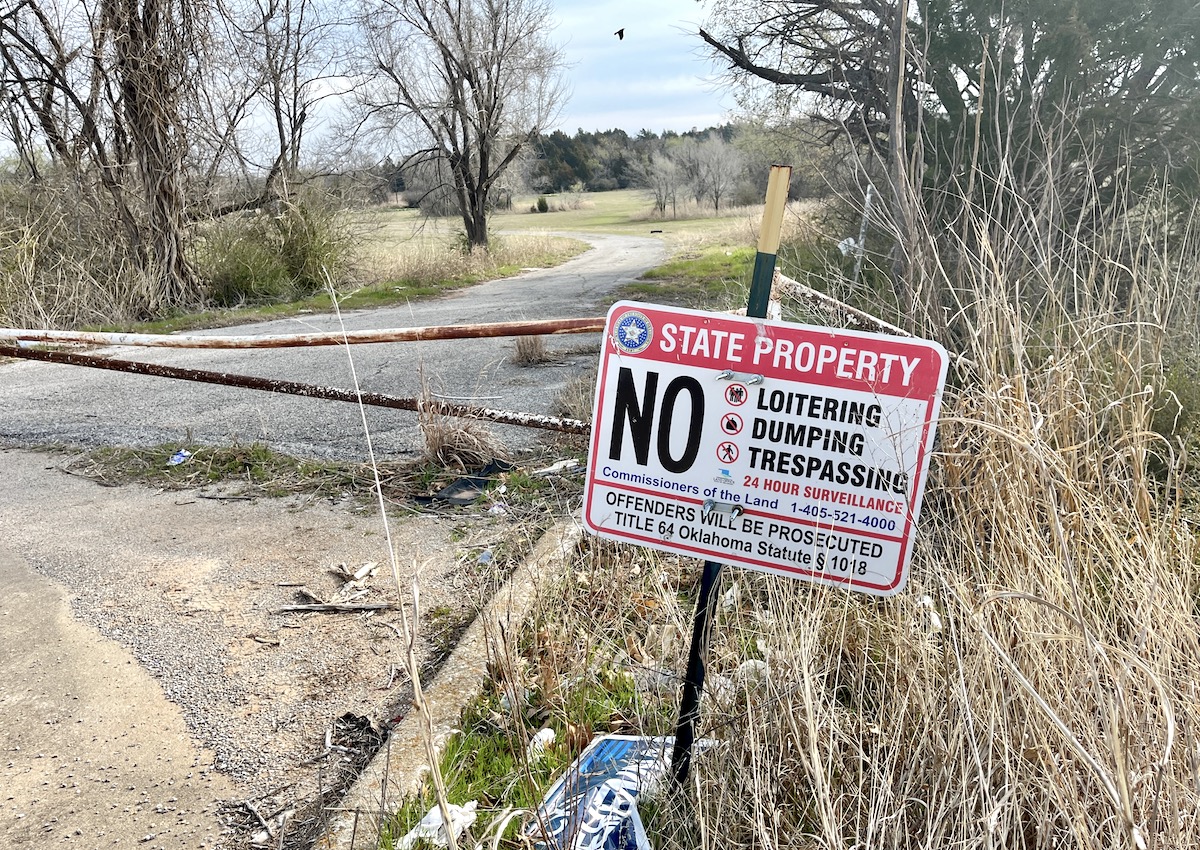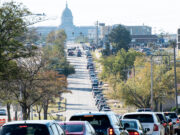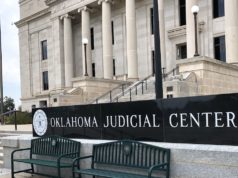

During a meeting of the Oklahoma Commissioners of the Land Office on March 9, state leaders approved a major land sale opportunity in Oklahoma City, authorized legal action in a property dispute regarding the Red River in Jefferson County and received an update on a negotiated settlement between the state and Symmetry to pay off gas bills inflated by Winter Storm Uri.
One of the most important yet somewhat obscure agencies in state government, the CLO manages state land, property assets and investments in an effort to maximize financial returns for local public school districts. The corpus of the agency’s trust fund stands at about $2.6 billion, and in 2022 it distributed more than $120 million to Oklahoma schools.
The agency is governed by a board featuring the state superintendent of public instruction, the state auditor and inspector, the lieutenant governor, the secretary of agriculture and the governor, who serves as its chairperson.
State negotiates $16 million gas bill down to $5.6 million
At the start of the March 9 CLO board meeting, Secretary Dan Whitmarsh told members of “good news” regarding the inflated natural gas bills racked up by state agencies during the February 2021 historic storm event.
Whitmarsh, who assumed leadership of the CLO after controversial Secretary Elliot Chambers resigned last year, offered a lengthy explanation about the situation, noting that CLO negotiators cut the state’s natural gas bill — from a company called Symmetry — by roughly two-thirds.
“In 2021 and years prior, the CLO administered the natural gas marketing program for the State of Oklahoma. The program purchased natural gas for 36 state agencies and universities at 108 locations across the state through a contract between OMES and Symmetry. (…) In March (2021), the CLO received an invoice for $16 million from Symmetry for natural gas delivered the month prior. The CLO declined to pay the invoice because the amount claimed was 40 times greater than a typical February, roughly $400,000,” Whitmarsh said. “Our legal and royalty compliance divisions entered the fray by demanding documents, analyzing data, and trying to find solutions. It took almost two years to sort this mess out but, with the help of Secretary of Energy and Environment Ken McQueen, we negotiated a $5.6 million settlement, roughly one third of the original invoice.”
Whitmarsh said the affected state agencies and universities paid $400,000 toward the settlement, and earlier this month the Legislature passed a supplemental appropriation to the CLO covering the remaining $5.2 million.
“CLO staff could have simply paid the Symmetry invoice and passed along the $16 million headache to the affected state agency and university customers,” Whitmarsh said. “Instead, CLO staff spent two years pushing back against the claim and negotiating a settlement. While $5.6 million is still a lot of money, it is $10.4 million less than the original invoice, and that figure does not even consider the additional costs of litigation and interest.”
The ability of CLO leaders to negotiate a 67.5 percent reduction in state agencies’ Winter Storm Uri gas bills may raise eyebrows for average Oklahoma residents and business owners who have been informed that their gas and electric bills will be inflated for about two decades owing to the February 2021 natural gas price spike. Legislators and state leaders created a mechanism by which OG&E, AEP-PSO and Oklahoma Natural Gas ratepayer debt could be securitized — bundled and sold on the bond market as negotiated instruments — to avoid higher interest rates on loans that they could take out on their own. (Lawmakers also created a way for the Grand River Dam Authority and the Oklahoma Municipal Power Authority could securitize and extend payment of their inflated gas bills, but those entities chose not to do so.)
Asked how the 36 state agencies were able to negotiate such a steep decrease in their bill from Symmetry, House Appropriations and Budget Chairman Kevin Wallace (R-Wellston) said the circumstances offered the state leverage.
“It was one of those type of deals where if you sue the state, you’re not going to be their vendor. So I think they had more incentive to negotiate and get down to a bottom dollar where this was their cost,” Wallace said. “A single-meter customer versus the state through CLO having multiple meters and higher usage, yeah, they can negotiate a better deal.”
Wallace noted a recent lawsuit filed by the attorney general of Kansas against a similar company to Symmetry, which alleges that Macquarie Energy engaged in an artificially inflated sale of natural gas in order to raise prices during the historic February 2021 winter storm that saw fuel costs spike to record levels.
“When this all happened, my first request was for anybody who could afford to pay their bill, let them pay their bill and then their bill wouldn’t go up. But it became an accounting and management nightmare,” Wallace said.
Senate Appropriations and Budget Chairman Roger Thompson (R-Okemah) said “that’s a good question” when asked why the state was able to negotiate a cost reduction with Symmetry while regulated utilities in the state were not.
“There was a bad idea and a worse idea, as far as I am concerned,” said Thompson, who noted that his own businesses’ bills would have been more than $14,000 if securitization had not allowed deferred payment over decades. “I thought at that time that it really helped the ratepayers.”
Symmetry Energy Solutions was previously called CenterPointe Energy.
CLO joins renewed Red River fight, which has lingered decades
During the March 9 meeting, CLO board members approved joining an upcoming lawsuit regarding ownership of property along the Red River in and around Jefferson County in southern Oklahoma.
Asked to clarify the case and CLO’s involvement, communications director David White provided a statement.
“The CLO owns a mineral interest in a parcel of land along the Red River in Jefferson County. Recently, a deed was filed by an adjoining landowner that potentially clouds title,” White said. “The surface owner intends to file a quiet title action in federal court. The surface owner is represented by the firm of MaHaffey Gore. The CLO has a preexisting contract with MaHaffey Gore and the firm has offered to represent the CLO in this matter at no cost. The surface owner will pay the legal fees. The litigation will ensure that the mineral interest of the CLO remains unencumbered by an onerous deed. If the CLO does not join as a plaintiff, the CLO will be named as a defendant. ”
Fights between Oklahomans and Texans over land in the Red River basin are nothing new. In 1985, the Los Angeles Times chronicled a dispute over a similar area near the border in Jefferson County.
Many eyes on 135 acres south of I-44 in northeast OKC

Speaking of land, about 135 acres of it northeast of the intersection of Lincoln Boulevard and Northeast 50th Street in Oklahoma City has been owned by the state of Oklahoma since 2014, when a land swap with Hobby Lobby provided the company with a parcel near its headquarters in SWOKC. In exchange, Hobby Lobby paid about $7.6 million for the four properties, the largest of which is 133 acres.
Located next to the Burr Oaks Subdivision, the parcels have long been an enormous domino waiting to fall in OKC’s development landscape. Dozens of homes or even high-density apartments could fit on the property, which abuts the south side of Interstate 44.
On March 9, the CLO board authorized the agency to put the land up for sale or consider a swap for other property similar to the 2014 agreement with Hobby Lobby, which gave the agency the 135 acres as well as the Frates Building at 5005 N. Lincoln Blvd. (That property included land on which the new Oklahoma Insurance Department building was constructed.)
CLO’s mission involves maximizing land lease revenue, mineral rights revenue and property taxes paid to public school districts and other local governments. Development of the 135 acres at Lincoln Boulevard and Northeast 50th Street could create additional property tax revenue for Oklahoma City Public Schools and Oklahoma County government.
(Correction: This article was updated at 8:42 p.m. Monday, March 20, to correct reference to the membership of the Commissioners of the Land Office governance board.)




















